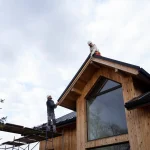Building a roof is a major project. It’s not just about putting up shingles; it’s about ensuring your home is safe, durable, and weather-resistant. But when it comes to roofing, should you roll up your sleeves and do it yourself or hire a professional? Let’s explore the pros and cons of each option to help you make the best decision for your home.
The Allure of DIY Roofing
DIY projects can be incredibly rewarding. They offer a sense of accomplishment and can save money if done correctly. For handy homeowners, the idea of tackling a roof might seem like a fun challenge.
Pros of DIY Roofing
- Cost Savings: By doing the work yourself, you can save on labor costs. This can be a significant saving, especially for smaller projects.
- Learning Experience: Roofing can teach you valuable skills. If you enjoy hands-on work, this can be a fulfilling project.
- Control Over the Project: You have complete control over the materials, schedule, and process.
Cons of DIY Roofing
- Safety Risks: Roofing is dangerous. Matt Cohler, a certified roofing contractor and safety instructor, warns, “Roofing projects are inherently dangerous. If you’re not comfortable working at heights or lack the proper safety equipment and training, leave it to the professionals” (NRCA).
- Potential Mistakes: Improper installation can lead to leaks and structural damage. According to Sarah Bell, a building inspector and code enforcement officer, “Improper roof installation can lead to leaks, structural damage, and even void your roof’s warranty” (NAHB).
- Hidden Costs: David Meurer, co-founder of the Roofers Association of Minnesota, notes, “While DIY roof repair might seem like a way to save money upfront, hidden costs like material waste and potential mistakes can negate those savings” (RAM).
The Case for Hiring a Professional
Professional roofers bring expertise, experience, and efficiency to the table. They can handle complex projects and ensure everything is up to code.
Pros of Hiring a Professional
- Expertise: Professionals have the training and experience to handle roofing projects efficiently and safely. Mike Holmes, a Canadian contractor and renovation expert, says, “A reputable roofing contractor will offer transparent quotes, detailed warranties, and references to verify their work” (Make It Right).
- Safety: Professionals have the necessary safety equipment and know-how to work safely at heights.
- Quality Work: A professional installation meets building codes and manufacturer specifications, ensuring your roof lasts longer and performs better.
Cons of Hiring a Professional
- Cost: Hiring a professional can be expensive. However, this cost often includes a warranty and peace of mind.
- Less Control: You may have less control over the project details, but a good contractor will keep you informed and involved in decision-making.
When to DIY and When to Hire a Pro
DIY Situations
- Minor Repairs: If you’re just replacing a few shingles or fixing a small leak, DIY might be a good option.
- Experienced Handy Homeowners: If you have experience with similar projects and feel confident in your skills, DIY can be rewarding.
- Low-Risk Projects: Projects that are closer to the ground or have minimal risk of structural damage are more suitable for DIY.
Hire a Pro Situations
- Large or Complex Projects: For extensive repairs, new installations, or complex roof designs, hiring a professional is the best choice. Roseanne Strickland, president of the National Women in Roofing, advises, “For complex roof designs, extensive repairs, or situations requiring permits, hiring a professional roofer with experience in those areas is the safest and most efficient option” (NWR).
- Safety Concerns: If you’re uncomfortable with heights or lack proper safety equipment, it’s safer to hire a professional.
- Building Codes and Permits: Professionals are familiar with local building codes and can handle the necessary permits and inspections.
Key Considerations
Safety First
The National Institute for Occupational Safety and Health (NIOSH) conducted a study on rooftop fall injuries, highlighting the importance of safety measures in roofing work (OSHA). Falls are a leading cause of injury in roofing, underscoring the risks involved.
Cost vs. Value
The National Association of Home Builders (NAHB) offers insights into homeowner spending on roof repairs and replacements. Weighing the potential cost savings of DIY against the risk of costly repairs if something goes wrong is crucial (NAHB).
Finding a Good Contractor
Consumer Reports provides a guide on selecting a qualified roofing contractor. Look for licensing, insurance, and references to ensure you’re hiring someone reliable (Consumer Reports).
Personal Insights
From my experience, taking on a DIY project like roofing can be a mixed bag. When I first considered fixing my roof, I was excited about the challenge. But after reading up on the risks and potential pitfalls, I decided to hire a pro. It was more expensive, but the peace of mind was worth it. Plus, the job was done in a fraction of the time it would have taken me.
Conclusion
Deciding whether to DIY or hire a pro for your roofing project depends on several factors, including the project’s scope, your experience level, and your comfort with heights and safety risks. While DIY can be a rewarding and cost-saving option for minor repairs and experienced handy homeowners, hiring a professional is often the safer and more efficient choice for larger, more complex projects.
Remember, your roof is a critical part of your home’s structure and protection. Ensuring it’s done correctly is paramount, whether you choose to do it yourself or hire a pro. Take the time to evaluate your situation carefully, considering all the pros and cons, before making your decision.
Cluster Pages









